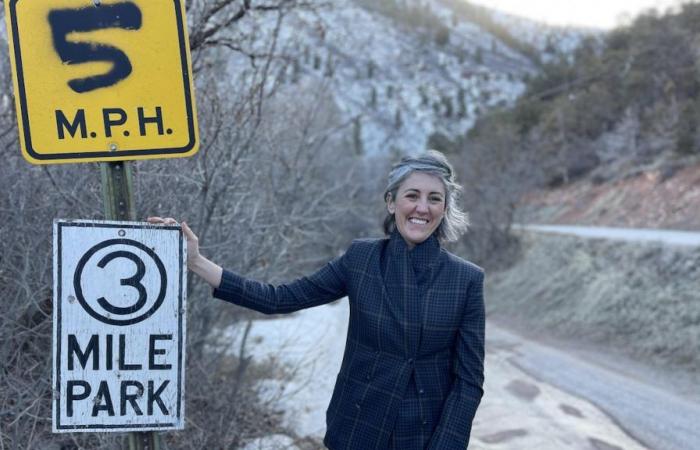Brianda Cervantes walks down the dirt road of Three Mile Mobile Home Park in Colorado. Around her, the mobile homes are sheltered by the canopy of tall trees and surrounded by mountains.
years they have lived here”,”text”:”Here we have Silverio and his family. This is Magdalena’s family. And this is the Jimenez family. They’ve lived here for 35 years”}}”>Here we have Silverio and his family. There is Magdalena’s family. And there is the Jimenez family. They have lived here for 35 years.
she lists after crossing the pedestrian bridge that connects the two parts of the park.
Ms. Cervantes is the manager and community organizer of the Three Mile Mobile Home Parklocated at Glenwood Springsin western Colorado, which includes 20 prefabricated homes and about 100 residents.
In this small community less than an hour from the chic ski resort of Aspen, an innovative experiment in preserving affordable housing is taking place.
Open in full screen mode
Brianda Cervantes chats with a park resident.
Photo : Frédéric Arnould
After the death in 2021 of Ben Krueger, who had owned the park since 1980, the future was uncertain for residents. A neighboring park had just been purchased by a large company at a cost well above the asking price. The company was in contact with the children of the previous owner, who had inherited the park.
It was clear from the beginning that his children [ceux de Ben Krueger] had no intention of handling it [le parc]but that they had at heart the well-being of the people who live there
, notes Sydney Schalit. She is director of Manaus, a non-profit organization which aims to carry out projects favorable to social justice.
It was Felix Jimenez, a long-time resident, who eventually sought help from Manaus so residents could acquire their park. This project seemed very unrealistic at first.
In Colorado, the law gives mobile home park residents 120 days to attempt to buy out their community. Despite this delay and the titanic efforts deployed in other local communities to set up a residents’ association and raise funds, Sydney Schalit saw several initiatives similar to that of Felix Jimenez bite the dust.
They would come to the negotiating table and there could be million-dollar overbids. The residents didn’t stand a chance.
Sydney Schalit and her colleagues at the Roaring Fork Community Development Corporationan organization under the umbrella of Manaus, contacted the owners even before the park was put up for sale. In 2022, they managed to conclude the purchase for a total of 2.4 million US dollars, a sum raised through a loan and crowdfunding.
The goal: to manage the park while waiting for residents to become its real owners in the coming years.
Open in full screen mode
A view of the Three Mile Mobile Home Park in Glenwood Springs, Colorado.
Photo : Frédéric Arnould
David versus Goliath
Sydney Schalit’s initiative is not unique. Faced with the appetite of institutional investors, investment funds and even large companies who are snapping up mobile home parks in Colorado and the rest of the United States, more and more residents are seeking to acquire the park. where they live.
Although these residents most of the time own their mobile homes, they rarely own the land where they are located, thus making them vulnerable to the staggering rent increases that often accompany the arrival of these large landlords.
One of the big benefits of the resident-owned park model is that rents remain stable.
notes Mike Bullard, vice president of communications at ROC USA, an organization that aims to facilitate the acquisition of mobile home parks by the people who live there. Since 2008, ROC USA and its ten affiliated organizations have helped residents of 327 mobile home parks purchase their communities in 21 U.S. states.
The process is well-oiled: initially, residents must form a cooperative, which then takes out a loan. Most of the time, residents turn to ROC USA Capitalthe organization’s affiliated community development corporation, which offers them low-interest loans. The catch is that the acquisition often comes with a substantial rent increase.
On the other hand, this increase is not used to generate profit, but to repay the loan and pay for the maintenance of the park. And the sellers are also winners since they are offered the market price.
It doesn’t take long for this choice to pay off for residents. In general, these parks then only increase their rent by 0.9% annually on average, an increase well below that of the industry, estimated at 6.2%. After five years, rents can be up to 17% lower than the market, according to Mike Bullard.
Despite the successes of the model, the speculative frenzy in the prefabricated housing sector can sometimes put obstacles in the way of residents. Over the past ten years, parks accompanied by ROC USA sold for an average of US$3.6 million.
$ per month is not viable”,”text”:”We do our research before proposing our model to mobile home owners because people have to be able to absorb the rent increase necessary for the acquisition. If we have to increase the rent by $1000 per month, it is not viable”}}”>We do our research before we offer our model to mobile home owners because people have to be able to afford the rent increase that is required to buy a home. If we have to increase the rent by $1,000 a month, it’s not viable.
notes Mike Bullard, who points out in passing that his organization works exclusively with low- and middle-income communities.
However, when successful, these initiatives help maintain a vital source of affordable housing, according to Esther Sullivan, a professor at the University of Colorado in Denver. These houses also represent the only source of financial assets for many low-income households.
she adds.
Report by Frédéric Arnould and Ariane Labrèche.
Photo : Frédéric Arnould
Intangible value
Typically, when a mobile home park goes up for sale in the United States, there are two scenarios: the park will be acquired by a big player, who will sharply increase rents, or it will be razed to make way for shopping malls or even university buildings.
As part of his research for his book entitled Manufactured Insecurity – Mobile Home Parks and Americans’ Tenuous Right to Place, Professor Esther Sullivan has lived in several mobile home parks in the United States. She has witnessed some of them being closed.
The evictions she’s witnessed when parks are bought out or closed have very real consequences for residents’ health, she says. A park that closes is the dismantling of a community. During my fieldwork, I saw people get sick and even die during an eviction process
she says.
For her, the loss of these communities comes with the loss of intangible wealth, namely very strong support networks between residents.
I don’t want to romanticize these communities, because I’m not a writer. Sometimes people gossip or argue. But there’s also a lot of solidarity, which is sometimes even more important for people on lower incomes, who have less financial support.
she emphasizes.
Open in full screen mode
Brianda Cervantes is the manager and community organizer at Three Mile Mobile Home Park.
Photo : Frédéric Arnould
This is one of the great benefits observed in parks owned by their residents in the form of a cooperative, according to Mike Bullard, of ROC USA. Collective meals prepared for a mother who has to undergo chemotherapy or even surveillance networks for vulnerable people, these are just a few examples among many others of this increased support between neighbors.
It transforms everyday life in a way that is difficult to quantify.
says M. Bullard.
These are the kinds of connections that Brianda Cervantes wants to strengthen between members of the diverse community of Three Mile Mobile Home Park. Here, some residents clean in the local luxury hotels, work in education or even work in the construction sector. About 80% of residents are of Latino origin and the majority of the remainder are retired people.
Everyone has Brianda’s phone number, who can be reached at all times. A single parent who has herself experienced residential insecurity, the park manager wants to do her part to preserve affordable housing in her community.
The goal here is to train residents and give them the tools they need to manage the park themselves in the future.
, she says. Last year, the community organized its first collective cleaning, a day that ended with tacos and lots of optimism for their new cooperative model.
Despite the victory, Sydney Schalit of Manaus already sees the challenges ahead for the community. She estimates that about $2 million more will be needed to maintain the park. The pedestrian bridge will need to be replaced, the water system upgraded. Already, the viability of the model is being tested.
But at the end of the day, it’s a beautiful place, and the residents are dedicated. We’re going to do everything we can to make it work.
she assures.






